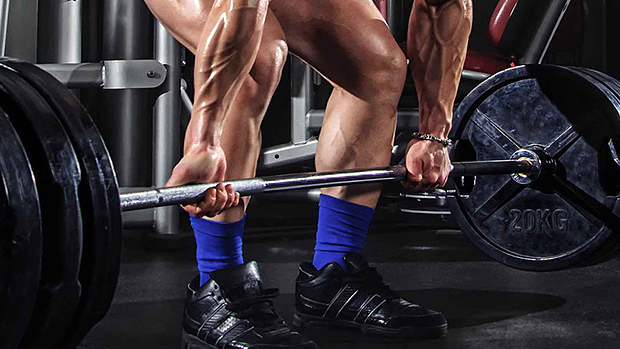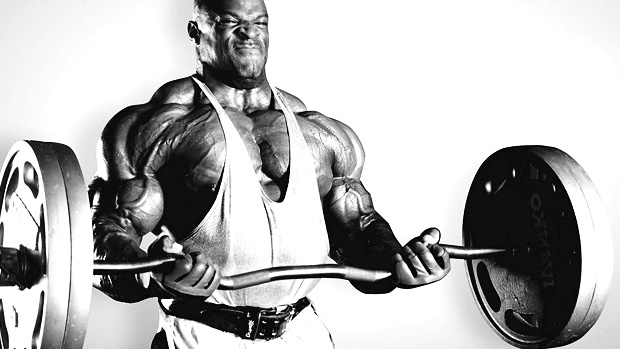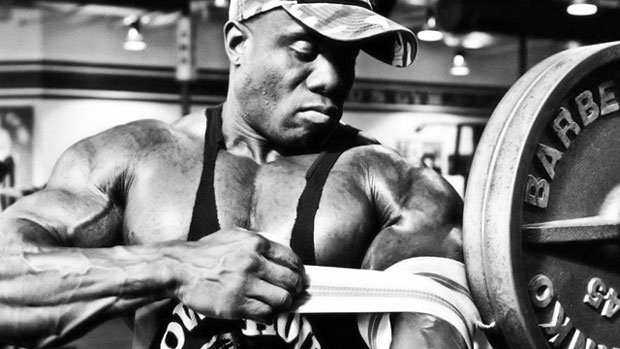Touching, Not Bouncing
Touch 'n go deadlifts often get labeled as "bouncing" or "cheating" deadlifts, but they're not. A bouncing deadlift is where the lifter forcefully uses the eccentric (lowering) phase to bounce the bumper plates off the floor to start the next rep. The bounce effectively removes some of the range of motion.
A real touch 'n go deadlift is different. It involves tapping the plates on the floor and, instead of coming to a complete stop, going right into your next rep.
Touch 'n Go Conventional Deadlifts
The obvious advantage with this style of deadlift is faster cycle rate. In CrossFit, competitors use this style in conditioning work or competitions to decrease the time of their sets. (Resetting on each rep would significantly increase their set times.)
Better competitors can complete heavy touch n' go deadlifts while keeping their spine in neutral position, but clearly there are some things that can go wrong. In competition, many athletes will sacrifice their bodies to get the prescribed work done. This is the shit you often see on social media, but this is not what we're looking for.
The EMOM Advantage
Touch 'n go deadlifts can be used effectively with EMOM work, which stands for "every minute on the minute." This is where you set a timer and do a certain amount of reps at the top of each minute, resting until the top of the next minute.
EMOM work allows you to keep your training sessions brief by performing a high amount of volume in a relatively short period of time.
The purpose of EMOM work is to improve your ability to recharge your battery (ATP) and to complete your work with short bouts of rest. As your aerobic system improves, you'll be able to replenish ATP faster, allowing you to perform your work without excessive bouts of rest while still being technical proficient.
In addition, there's a challenge that comes with performing touch 'n go reps: holding onto the bar longer produces more time under tension as well as an increased metabolic demand.
Practice sets of triples with a light load (50% or less of your 1RM) if you're not already experienced with touch n' go sets.
Coaching Cues
- Set-up with a hip-width stance, toes slightly pointed out.
- Make sure your head starts in neutral position, looking out just past your toes.
- Make sure your hips and shoulders rise at the same rate. No "stripper deadlifts." Your head will travel with the natural course of your body.
- You should be tight the entire time: lats engaged, lumbar tight.
- Think about actively "screwing your feet into the floor" before pulling your first rep. This will turn on the musculature of your hamstrings and glutes.
- When lowering the weight, keep the bar close to your body (bar should ride down your thighs). As the bar passes your knees, drop your hips slightly to ensure you're using your legs and not just your lower back. These should NOT look like Romanian deadlifts where your hips remain in a higher, static position.
- Tap the plates to the floor and initiate your next rep.
Programming
- Week 1: EMOM for 8 minutes: 3 touch 'n go deadlifts at 60% of your 1RM. (So, at the top of each minute, you'll do 3 reps. That's 24 reps in 8 minutes.)
- Week 2: EMOM for 6 minutes: 3 touch 'n go deadlifts at 65% of your 1RM.
- Week 3: EMOM for 4 minutes: 3 touch 'n go deadlifts at 70% of your 1RM.
- Week 4: OFF from deadlifts
- Week 5: EMOM for 10 minutes: 2 touch 'n go deadlifts at 70% of your 1RM.
- Week 6: EMOM for 8 minutes: 2 touch 'n go deadlifts at 75% of your 1RM.
- Week 7: EMOM for 6 minutes: touch 'n go deadlifts at 80% of your 1RM.





